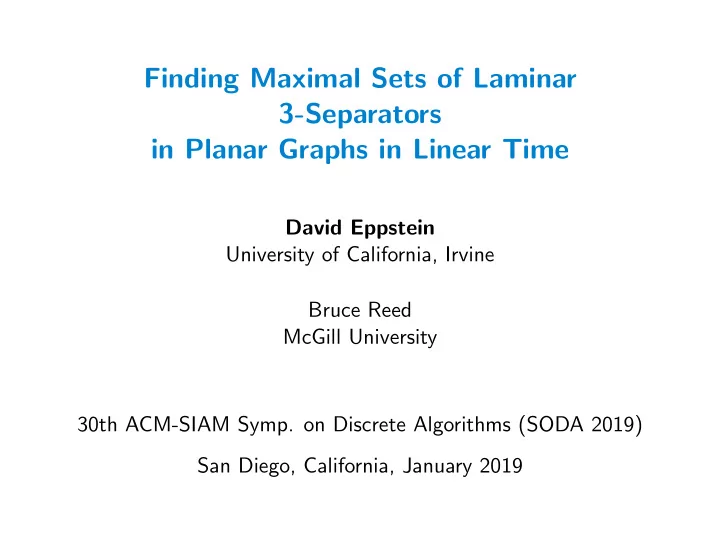

Finding Maximal Sets of Laminar 3-Separators in Planar Graphs in Linear Time David Eppstein University of California, Irvine Bruce Reed McGill University 30th ACM-SIAM Symp. on Discrete Algorithms (SODA 2019) San Diego, California, January 2019
Principle: Connectivity ⇒ more structure Examples: ◮ 2-edge-connected and 3-regular ⇒ perfect matching [Petersen 1891] ◮ 3-vertex-connected and planar ⇒ realization as convex polyhedron [Steinitz 1922] ◮ 4-vertex-connected and planar ⇒ K 5 -minor-free [Wagner 1937] ◮ 4-vertex-connected and planar ⇒ Hamiltonian [Tutte 1977]
Algorithmic version of connectivity principle Solve problems by dividing into more-connected pieces, using structure, and gluing solutions together [Swallow 2013]
Canonical partition by 1-vertex cuts Block (biconnected component): equivalence class of edges under relation of belonging to a simple cycle Articulation point : vertex in ≥ 2 components Block-cut tree : bipartite incidence graph of blocks and articulation points [Zyqqh 2010]
Canonical partition by 2-vertex cuts SPQR tree: Tree with vertices labeled by cycles (S), dipoles (P), and 3-vertex-connected graphs (R) Tree edges ⇒ glue graphs on shared edge and delete the edge [Mac Lane 1937; Hopcroft and Tarjan 1973; Bienstock and Monma 1988; Di Battista and Tamassia 1990] R R S P R
But partition by 3-vertex cuts is not canonical! Main theorem: Given a 3-vertex-connected planar graph we can find a maximal, laminar set of 3-cuts in linear time
Why? Faster separator construction for minor-closed graph families [Kawarabayashi, Li, and Reed, announced] uses as subroutine Finding pairs of vertex-disjoint paths between given terminals in arbitrary graphs [Kawarabayashi et al. 2015] uses as subroutine Finding maximal laminar family of 3-separators in planar graphs [this paper!] [Goldberg 1931]
Certifying the results for two disjoint paths Add 4-wheel on path terminals to input graph. Then either: ◮ Find two paths ⇒ ∃ K 5 minor ◮ Reduce graph on 3-vertex cuts to planar component containing wheel ⇒ ∄ paths
Recursive algorithm for two paths (sketch) 1. Find a large set of contractable edges and contract them 2. Recurse! 3(a). If found two paths, expand them back out 3(b). If found planar component, solve the problem using laminar 3-vertex cuts within the component to decompose it into subproblems [danipaul 2018]
Naive algorithm for laminar cuts 1. Find all cuts, and all non-laminar pairs of cuts 2. Build a graph, vertices = cuts, edges = non-laminar pairs 3. Find a maximal independent set (linear time in size of graph) But: How to find everything? And how big is the graph?
Finding cuts and non-laminar pairs Replace input graph by its vertex-edge-face incidence graph Turns 3-vertex cuts into certain 6-cycles, non-laminar pairs into 12-edge subgraphs Planar subgraph isomorphism can find them all in O (1) time per subgraph [Eppstein 1999]
. . . but the cut–crossing graph is too big! Wheels have Θ( n 2 ) 3-vertex cuts, and Θ( n 4 ) non-laminar pairs
Our solution (sketch) Wheels are the only bad case! So. . . 1. Find wheel-like subgraphs in vertex-edge-face incidence graph 2. Find cuts within each subgraph (easy) 3. Cut H into pieces along the edges of the subgraphs; each piece has only O ( n ) cuts and crossings 4. Construct each piece’s cut–crossing graph and find a maximal independent set in each piece [Lombroso 2015]
Conclusions Linear-time decomposition of planar graphs by 3-vertex cuts [Pandian 2018] Allows extra constraints on the cuts (needed in application) Application to disjoint paths and separators; more applications? Is there a nice linear-space description of all 3-vertex cuts, like the SPQR tree for the 2-vertex cuts? What about nonplanar graphs?
References and image credits, I Daniel Bienstock and Clyde L. Monma. On the complexity of covering vertices by faces in a planar graph. SIAM Journal on Computing , 17 (1):53–76, 1988. doi: 10.1137/0217004 . danipaul. Droste Effect. Reddit GIMP group, 2018. URL https: //www.reddit.com/r/GIMP/comments/8pmgv4/droste_effect/ . G. Di Battista and R. Tamassia. On-line graph algorithms with SPQR-trees. In Proc. 17th Internat. Colloq. Automata, Languages and Programming (ICALP 1990) , volume 443 of Lect. Notes in Comput. Sci. , pages 598–611. Springer, 1990. doi: 10.1007/BFb0032061 . D. Eppstein. Subgraph isomorphism in planar graphs and related problems. J. Graph Algorithms Appl. , 3(3):1–27, 1999. doi: 10.7155/jgaa.00014 . Rube Goldberg. Self-operating napkin. Collier’s , September 26 1931. URL https://commons.wikimedia.org/wiki/File:Self-operating_ napkin_(Rube_Goldberg_cartoon_with_caption).jpg .
References and image credits, II John Hopcroft and Robert Tarjan. Dividing a graph into triconnected components. SIAM Journal on Computing , 2(3):135–158, 1973. doi: 10.1137/0202012 . K. Kawarabayashi, Z. Li, and B. Reed. Connectivity preserving iterative compaction and finding 2 disjoint rooted paths in linear time. Electronic preprint arxiv:1509.07680, 2015. Lombroso. Pizza wheel. Public domain (CC0) image, 2015. URL https://commons.wikimedia.org/wiki/File: Pizza_wheel_(2015-06-20).jpg . S. Mac Lane. A structural characterization of planar combinatorial graphs. Duke Math. J. , 3(3):460–472, 1937. doi: 10.1215/S0012-7094-37-00336-3 . Vijai Pandian. Helpful tips for pruning landscape trees for maximum stability. Green Bay Press Gazette , March 30 2018. URL https: //www.greenbaypressgazette.com/story/life/2018/03/30/ helpful-tips-pruning-landscape-trees-maximum-stability/ 471025002/ . Image credited to University of Wisconsin Extension.
References and image credits, III Julius Petersen. Die Theorie der regul¨ aren graphs. Acta Math. , 15: 193–220, 1891. doi: 10.1007/BF02392606 . Ernst Steinitz. Polyeder und Raumeinteilungen. In Encyclop¨ adie der mathematischen Wissenschafte, Band 3 (Geometries) , volume IIIAB12, pages 1–139. 1922. Erica Swallow. U.S. Senate More Divided Than Ever Data Shows. Forbes , November 17 2013. URL https://www.forbes.com/sites/ericaswallow/2013/11/17/ senate-voting-relationships-data/#60f4c8344031 . W. T. Tutte. Bridges and Hamiltonian circuits in planar graphs. Aequationes Math. , 15(1):1–33, 1977. doi: 10.1007/BF01837870 . K. Wagner. ¨ Uber eine Eigenschaft der ebenen Komplexe. Math. Ann. , 114:570–590, 1937. doi: 10.1007/BF01594196 . Zyqqh. Biconnected components of an undirected graph. CC-BY-3.0 licensed image, June 17 2010. URL https://commons.wikimedia.org/wiki/File: Graph-Biconnected-Components.svg .
Recommend
More recommend